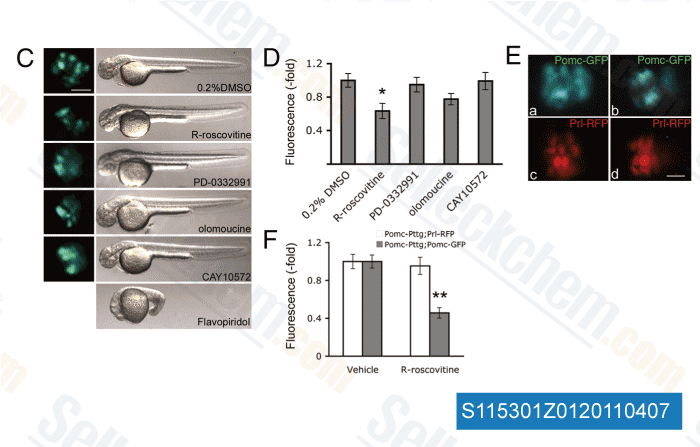|
Toll Free: (877) 796-6397 -- USA and Canada only -- |
Fax: +1-832-582-8590 Orders: +1-832-582-8158 |
Tech Support: +1-832-582-8158 Ext:3 Please provide your Order Number in the email. |
Technical Data
| Formula | C21H20ClNO5.HCl |
|||
| Molecular Weight | 438.3 | CAS No. | 131740-09-5 | |
| Solubility (25°C)* | In vitro | DMSO | 88 mg/mL (200.77 mM) | |
| Water | 37 mg/mL (84.41 mM) | |||
| Ethanol | Insoluble | |||
|
* <1 mg/ml means slightly soluble or insoluble. * Please note that Selleck tests the solubility of all compounds in-house, and the actual solubility may differ slightly from published values. This is normal and is due to slight batch-to-batch variations. * Room temperature shipping (Stability testing shows this product can be shipped without any cooling measures.) |
||||
Preparing Stock Solutions
Biological Activity
| Description | Flavopiridol (Alvocidib) HCl competes with ATP to inhibit CDKs including CDK1, CDK2, CDK4 and CDK6 with IC50 of ~ 40 nM in cell-free assays. It is 7.5-fold more selective for CDK1/2/4/6 than CDK7. Flavopiridol is initially found to inhibit EGFR and PKA. Flavopiridol HCl induces autophagy and ER stress. Flavopiridol HCl blocks HIV-1 replication. Phase 1/2. | ||||||||||
|---|---|---|---|---|---|---|---|---|---|---|---|
| Targets |
|
||||||||||
| In vitro | Flavopiridol is initially found to inhibit the epidermal growth factor receptor and protein kinase A (IC50 = 21 and 122 μM). Flavopiridol is later shown to inhibit cell proliferation, at more physiologically relevant concentrations (IC50 = 66 nM) when Flavopiridol is tested in the National Cancer Institute Development Therapeutics Program panel of 60 human tumor cell lines. [1] Flavopiridol induces G1 arrest with inhibition of CDK2 and CDK4 in human breast carcinoma cells in a time and concentration dependent manner. [2] Short time treatment of Flavopiridol (~12 hours) induce apoptosis in hematopoietic cell lines including SUDHL4, SUDHL6 (B-cell lines), Jurkat and MOLT4 (T-cell lines ), and HL60 (myeloid). [3] In the clonogenic assay, Flavopiridol functions as a highly potent cytotoxic compound with a mean IC70 with 8 ng/mL in 23 human tumor models. [4] A recent study shows Flavopiridol treatment induces a substantial AKT-Ser473 phosphorylation in human glioblastoma T98G cell line. [5] | ||||||||||
| In vivo | At the maximal tolerated dose of 10 mg/kg/day administered p.o. on days 1-4 and 7-11, Flavopiridol effects tumor regression in PRXF1337 and tumor stasis lasting for 4 weeks in PRXF1369. [4] After treatment with 7.5 mg/kg Flavopiridol bolus intravenous (IV) or intraperitoneal on each of 5 consecutive days, 11 out of 12 advanced stage subcutaneous (s.c.) human HL-60 xenografts undergo complete regressions, and animals remain disease-free several months after one course of Flavopiridol treatment. SUDHL-4 s.c. lymphomas treated with flavopiridol at 7.5 mg/kg bolus IV for 5 days undergo either major (two out of eight mice) or complete (four out of eight mice) regression, with two animals remaining disease-free for more than 60 days. The overall growth delay is 73.2%. Daily IV or IP administration of flavopiridol results in peak plasma levels of about 7 µM, followed by a progressive decline to approximately 100 nM in 8 hours.[6] |
Protocol (from reference)
| Kinase Assay:[1] |
|
|---|---|
| Cell Assay:[2] |
|
| Animal Study:[4] [6] |
|
References
Customer Product Validation

-
Data from [Br J Cancer, 2014, 110(5), 1189-98]

-
Data from [Data independently produced by Mol Cancer Ther, 2012, 11(11), 2321-2330]

-
Data from [PNAS, 2011, 108, 8417]
Selleck's Flavopiridol (Alvocidib) HCl has been cited by 60 publications
| Monoallelically expressed noncoding RNAs form nucleolar territories on NOR-containing chromosomes and regulate rRNA expression [ Elife, 2024, 13e80684] | PubMed: 38240312 |
| From co-delivery to synergistic anti-inflammatory effect: Studies on chitosan-stabilized Janus emulsions having chloroquine phosphate and flavopiridol in Complete Freund's Adjuvant induced arthritis rat model [ Int J Biol Macromol, 2023, 258(Pt 1):128776] | PubMed: 38114014 |
| Claspin is Required for Growth Recovery from Serum Starvation through Regulating the PI3K-PDK1-mTOR Pathway in Mammalian Cells [ Mol Cell Biol, 2023, 43(1):1-21] | PubMed: 36720467 |
| Lamin A/C phosphorylation at serine 22 is a conserved heat shock response to regulate nuclear adaptation during stress [ J Cell Sci, 2023, 136(4)jcs259788] | PubMed: 36695453 |
| Brd4-dependent CDK9 expression induction upon sustained pharmacological inhibition of P-TEFb kinase activity [ Biochem Biophys Res Commun, 2023, 671:75-79] | PubMed: 37295357 |
| The super elongation complex drives transcriptional addiction in MYCN-amplified neuroblastoma [ Sci Adv, 2023, 9(13):eadf0005] | PubMed: 36989355 |
| Nuclear oligo hashing improves differential analysis of single-cell RNA-seq [ Nat Commun, 2022, 13(1):2666] | PubMed: 35562344 |
| p300/CBP sustains Polycomb silencing by non-enzymatic functions [ Mol Cell, 2022, 82(19):3580-3597.e9] | PubMed: 36206738 |
| Discovery of a large-scale, cell-state-responsive allosteric switch in the 7SK RNA using DANCE-MaP [ Mol Cell, 2022, S1097-2765(22)00114-9] | PubMed: 35320755 |
| ISR8/IRF1-AS1 Is Relevant for IFNα and NF-κB Responses [ Front Immunol, 2022, 13:829335] | PubMed: 35860270 |
RETURN POLICY
Selleck Chemical’s Unconditional Return Policy ensures a smooth online shopping experience for our customers. If you are in any way unsatisfied with your purchase, you may return any item(s) within 7 days of receiving it. In the event of product quality issues, either protocol related or product related problems, you may return any item(s) within 365 days from the original purchase date. Please follow the instructions below when returning products.
SHIPPING AND STORAGE
Selleck products are transported at room temperature. If you receive the product at room temperature, please rest assured, the Selleck Quality Inspection Department has conducted experiments to verify that the normal temperature placement of one month will not affect the biological activity of powder products. After collecting, please store the product according to the requirements described in the datasheet. Most Selleck products are stable under the recommended conditions.
NOT FOR HUMAN, VETERINARY DIAGNOSTIC OR THERAPEUTIC USE.
